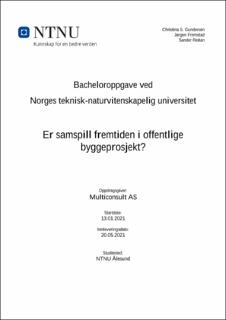| dc.contributor.advisor | Mørk, Max Ingar | |
| dc.contributor.author | Gundersen, Christina S. | |
| dc.contributor.author | Fremstad, Jørgen | |
| dc.contributor.author | Reitan, Sander | |
| dc.date.accessioned | 2021-09-24T19:19:27Z | |
| dc.date.available | 2021-09-24T19:19:27Z | |
| dc.date.issued | 2021 | |
| dc.identifier | no.ntnu:inspera:82686915:82688614 | |
| dc.identifier.uri | https://hdl.handle.net/11250/2782226 | |
| dc.description.abstract | Denne rapporten handler om samspillsentreprise og hvordan det blir brukt i offentlige byggeprosjekt. En entreprise er en strukturert avtale mellom byggherre og entreprenør. Denne organiserer prosjektgjennomføring, fordeler ansvar og regulerer de kommersielle forholdene mellom partene. Til nå har totalentrepriser vært den dominerende entrepriseformen, men ved mer komplekse prosjekter hvor det er behov for tettetere samarbeid, er det utviklet nye entrepriseformer.
Samspillsentreprise er en forholdsvis ny entrepriseform, som blir stadig mer brukt i offentlige prosjekt. Den kjennetegnes ved at det blir benyttet et tettere samarbeid mellom aktørene i prosjektet, og dermed får bedre utnyttet kompetansen i teamet, tverrfaglig. I dette ligger også god tilrettelegging for å avdekke endringsbehov allerede i en tidligfase, hvor konsekvensene og endringskostnadene er små.
Per dags dato er ikke samspillsentreprise en standardisert entrepriseform, noe som gjør det vanskelig å vite hvordan samspill skal gjennomføres, eller om det vil gi positive resultater. Dette behovet har utløst denne BSc-oppgaven, hvor vi går inn i konkrete prosjekter og analyserer utfallet.
Rapporten baseres på en kombinasjon av prosjektstudie og intervju. Prosjektstudiet består av fire skolebyggeprosjekter i Molde, Ålesund og Oslo, hvor tilhørende fylkeskommuner er offentlige byggherrer. Det undersøkes hvordan prosjektene har organisert og gjennomført samspillet i ulike prosjektfaser. Dette er koblet opp mot lønnsomhetsanalyser, for å vurdere effekten av Samspillsentreprisen. Studien tar utgangspunkt i et eksplorativt forskningsdesign, og baseres på en triangulær innsamlingsmetode med data fra tilhørende prosjektdokument og semistrukturerte dybdeintervju.
Resultatet av analysene viste at alle prosjektene hadde en mer effektiv og forutsigbar planlegging pga. den tverrfaglige kommunikasjonen som samspill legger opp til. Det kom også fram at behovet for samspill økter i takt med prosjektets kompleksitet, med stor påvirkning på prosjektets framdrift og økonomi. Samspillentreprisen vurderes derfor som en tids- og kostnadseffektiv entrepriseform, men trenger samtidig å videreutvikles for å få ut det fulle potensialet. Rapporten konkluderer derfor med at konseptet samspill er lønnsomt dersom de rette forutsetningene ligger til grunn. | |
| dc.description.abstract | This report is about partnering contract and how it is used in public construction projects. A contract is a structured agreement between the client and the contractor. This organizes project implementation, distributes responsibilities and regulates the commercial relations between the parties. Until now, turnkey contracts have been the dominant form of contract, but for more complex projects where there is a need for closer cooperation, new forms of contract have been developed.
Partnering contract is a relatively new form of contract, which is increasingly used in public projects. It is characterized by the use of closer collaboration between the actors in the project, and thus better utilization of the competence in the team, interdisciplinary. This also includes good facilitation to identify the need for change already at an early stage, where the consequences and change costs are small.
As of today, partner contracting is not a standardized form of contracting, which makes it difficult to know how the interaction will be carried out, or whether it will give positive results. This need has triggered this BSc thesis, where we go into specific projects and analyze the outcome.
The report is based on a combination of project study and interview. The project study consists of four school construction projects in Molde, Ålesund and Oslo, where the associated county municipalities are public developers. It is investigated how the projects have organized and implemented the interaction in different project phases. This is linked to profitability analyzes, in order to assess the effect of the partnering Contract. The study is based on an exploratory research design, and is based on a triangular collection method with data from the associated project document and semi-structured in-depth interviews.
The results of the analyzes showed that all the projects had a more efficient and predictable planning due to. the interdisciplinary communication that partnering provides. It was also revealed that the need for interaction increases in step with the project's complexity, with a major impact on the project's progress and finances. The partnering contract is therefore considered a time- and cost-effective form of contract, but at the same time needs to be further developed to reach its full potential. The report therefore concludes that the concept of partnering is profitable if the right conditions are in place. | |
| dc.language | nob | |
| dc.publisher | NTNU | |
| dc.title | Er samspill fremtiden i offentlige byggeprosjekt? | |
| dc.type | Bachelor thesis | |
